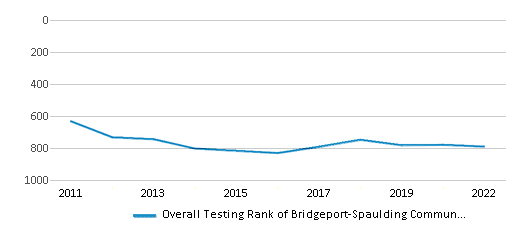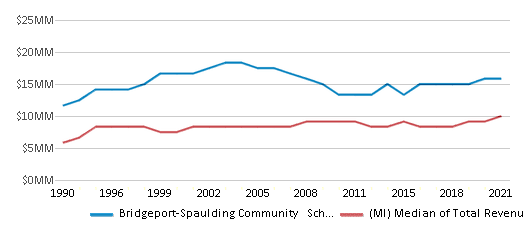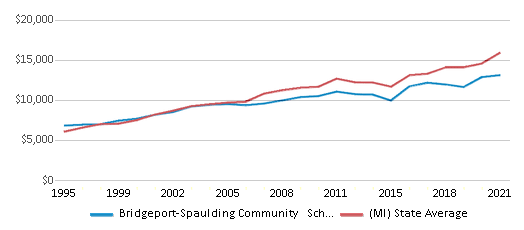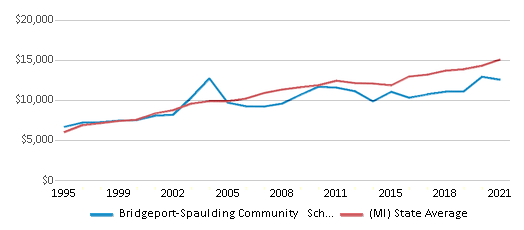For the 2025 school year, there is 1 public middle school serving 368 students in Bridgeport-Spaulding Community School District. This district's average middle testing ranking is 2/10, which is in the bottom 50% of public middle schools in Michigan.
Public Middle School in Bridgeport-Spaulding Community School District have an average math proficiency score of 8% (versus the Michigan public middle school average of 31%), and reading proficiency score of 23% (versus the 44% statewide average).
Minority enrollment is 88% of the student body (majority Black), which is more than the Michigan public middle school average of 42% (majority Black).
Overview
This School District
This State (MI)
# Schools
4 Schools
1,349 Schools
# Students
1,453 Students
537,315 Students
# Teachers
69 Teachers
31,652 Teachers
Student : Teacher Ratio
21:1
21:1
District Rank
Bridgeport-Spaulding Community School District, which is ranked within the bottom 50% of all 851 school districts in Michigan (based off of combined math and reading proficiency testing data) for the 2021-2022 school year.
The school district's graduation rate of 70-74% has decreased from 75-79% over five school years.
Overall District Rank
#790 out of 866 school districts
(Bottom 50%)
(Bottom 50%)

Math Test Scores (% Proficient)
6%
34%

Reading/Language Arts Test Scores (% Proficient)
17%
45%

Science Test Scores (% Proficient)
13%
38%

Graduation Rate
70-74%
81%

Students by Ethnicity:
Diversity Score
0.50
0.60
# American Indian Students
6 Students
5,345 Students
% American Indian Students
n/a
1%
# Asian Students
3 Students
19,936 Students
% Asian Students
n/a
4%
# Hispanic Students
187 Students
47,905 Students
% Hispanic Students
13%
9%
# Black Students
1,000 Students
122,970 Students
% Black Students
69%
23%
# White Students
189 Students
312,168 Students
% White Students
13%
58%
# Hawaiian Students
n/a
471 Students
% Hawaiian Students
n/a
n/a
# Two or more races Students
68 Students
27,717 Students
% of Two or more races Students
5%
5%
Students by Grade:
# Students in PK Grade:
-
-
# Students in K Grade:
92
17,744
# Students in 1st Grade:
99
17,631
# Students in 2nd Grade:
104
18,045
# Students in 3rd Grade:
89
17,646
# Students in 4th Grade:
99
18,813
# Students in 5th Grade:
96
26,385
# Students in 6th Grade:
96
87,228
# Students in 7th Grade:
136
103,285
# Students in 8th Grade:
136
102,692
# Students in 9th Grade:
158
33,855
# Students in 10th Grade:
114
31,157
# Students in 11th Grade:
113
30,339
# Students in 12th Grade:
121
30,343
# Ungraded Students:
-
2,152
District Revenue and Spending
The revenue/student of $13,308 in this school district is less than the state median of $18,510. The school district revenue/student has stayed relatively flat over four school years.
The school district's spending/student of $12,717 is less than the state median of $17,693. The school district spending/student has stayed relatively flat over four school years.
Total Revenue
$19 MM
$25,476 MM

Spending
$19 MM
$24,351 MM

Revenue / Student
$13,308
$18,510

Spending / Student
$12,717
$17,693

Best Bridgeport-Spaulding Community School District Public Middle Schools (2025)
School
(Math and Reading Proficiency)
(Math and Reading Proficiency)
Location
Grades
Students
Rank: #11.
Bridgeportspaulding Middle Schoolschrah
(Math: 8% | Reading: 23%)
Rank:
Rank:
2/
Bottom 50%10
3675 Southfield Dr
Saginaw, MI 48601
(989) 777-1600
Saginaw, MI 48601
(989) 777-1600
Grades: 6-8
| 368 students
Recent Articles

Year-Round Or Traditional Schedule?
Which is more appropriate for your child? A year-round attendance schedule or traditional schedule? We look at the pros and cons.

Why You Should Encourage Your Child to Join a Sports Team
Participating in team sports has a great many benefits for children, there is no doubt. In this article you will learn what those benefits are.

White Students are Now the Minority in U.S. Public Schools
Increasing birth rates among immigrant families from Asia and Central and South America, combined with lower birth rates among white families, means that for the first time in history, public school students in the United States are majority-minority. This shift in demographics poses difficulties for schools as they work to accommodate children of varying language abilities and socio-economic backgrounds.





